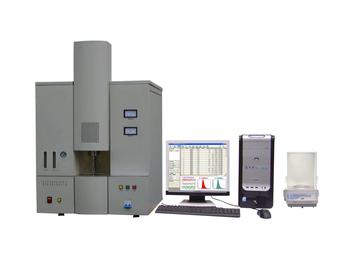Carbon* Analyzer Operating Principle
 The carbon-sulfur analyzer generally refers to the instrument's general term for the quantitative analysis of carbon and sulfur elements in steel materials. Its analytical methods and chemical principles are widely used. Understanding methods and principles is very important.
The carbon-sulfur analyzer generally refers to the instrument's general term for the quantitative analysis of carbon and sulfur elements in steel materials. Its analytical methods and chemical principles are widely used. Understanding methods and principles is very important. First, carbon 1, non-water method: the sample in the arc furnace through the combustion of oxygen to generate CO2, SO2, SO2 is first absorbed after removal of the remaining CO2 into the ethanol - ethanolamine - potassium hydroxide absorption solution absorption, and titration; ethanolamine The addition of CO2 increases the absorption to avoid titration and escape; ethanol is an amphoteric solvent, prone to proton transfer, promote the ionization of weak acids, thereby increasing the acidity to accelerate the reaction.
C2H5OHKOH=C2H5OKH2O
C2H5OKCO2=KC2H5CO3 (ethyl potassium carbonate)
NH2C2H4OHCO2=HOC2H4NHCOOH (2-hydroxyethylamine carboxylic acid)
HOC2H4NHCOOHC2H5OK=HOC2H4NHCOOKC2H5OH
2. Gas volumetric method: after the CO2 generated by the combustion of the sample is absorbed by KOH, the content is determined due to the decrease in volume. Because SO2 interferes with the measurement of C, SO2 can be filtered off with active MnO2 or silver vanadate.
CO22KOH=K2CO3H2O
Second, sulfur, acid and alkali neutralization method: the sample generated by the combustion of SO2, H2O generated sulfite, oxidized by H2O2 to sulfuric acid, using NaOH standard droplets, according to the consumption of S content obtained.
SO2H2O=H2SO3
H2SO3H2O2=H2SO4H2O
H2SO42NaOH=Na2SO42H2O
2. Iodometric method: After the SO2 generated from the combustion of the sample is absorbed by the weakly acidic starch solution, sulfite is generated, titrated with an iodine standard solution (or a potassium iodate standard solution), so that sulfuric acid is formed into sulfuric acid, and starch is used as an indicator. The S content is determined based on the standard fluid consumption volume.
SO2H2O=H2SO3
KIO35KL6HCL=3I26KCL3H2O
H2SO3I2H2O=H2SO42HI
Third, Mn, P, Si see the specification IV, Cr: (diphenyl phosphonium photometric method):
Samples are solubilized with high acid (or nitric acid, aqua regia, etc.), heated to high sour smoke, oxidized low chromium to high valence (hexavalent), in the presence of phosphoric acid (elimination of Fe interference) to diphenyl hydrazine and six Chromium reacts to form a purple-red chromium complex, which is used for photometric determination (λ = 540 nm). Diphenylhydrazine: Also known as diphenylcarbazide, diphenylcarbazide, diphenylcarbazide.
V. Cu: (BCO photometric method)
After the sample was dissolved in acid, fumaric acid smoked and citric acid masked Fe. In the ammoniacal medium with pH of 8.5-9.3, BCO formed a blue complex with Cu, and Cu was measured. (λ=600 nm).
Sixth, Mo: (** stannous reduction - sulphate photometry)
After the sample was dissolved in acid, the smoke was emitted, and the stannous chloride was used as a reducing agent (Mo six-five to five-valent). The pentavalent molybdenum and thionate formed an orange-red complex, and the absorbance was measured. Find the Mo content. (λ=460 nm). 530nm hexavalent chromium interferes.
7. Ni: (Iodine-dione oxime photometric method)
After the sample is dissolved in acid, Ni is reacted with diacetyl oxime to form a soluble burgundy complex in the presence of the (iodo) ammonia valence, and photometric determination is performed. Find the Ni content. (λ=530nm)
Eight, Ti (chromic acid spectrophotometry)
When the sample was acid-decomposed, tetravalent Ti and chromotropic acid formed a brown complex in an acidic medium (PH=3) in which ascorbic acid was present, and the Ti content was determined by photometric determination. (λ=500nm)
Chromotropic acid: sodium 1,8-dihydroxynaphthalene-3,6-disulfonate Nine, V: (sodium diphenylamine sulfonate photometric method)
After the sample is dissolved in acid, micro vanadium treatment oxidizes vanadium to pentavalent to selectively reduce hexavalent chromium. In the medium of mol/2H2SO4 and mol/2H3PO4, pentavalent vanadium oxidizes sodium diphenylamine sulfonate to purple color. The photometric measurement was performed to determine the V content. (λ=500nm)
Ten, ∑Re; (Azo III photometric method)
The sample was dissolved with acid and hydrogen peroxide, Fe was masked with oxalic acid, and tetravalent Ti was used to form a blue-green complex with CPAIII and the rare earth to perform photometric measurement to determine the Re content. (λ = 650 nm).
Rare earth elements: refers to the atomic number from 57-71 lanthanides and yttrium (Y).
Eleven, Mg: (CPAI spectrophotometry)
After the sample was acid-decomposed, polyvalent metal ions such as Fe, Al, Ti, Sn, and Zr were masked with diethanolamine, and EDTA-Pb masked Fe, Ni, Co, and Re elements. The phenanthroline and ethylenediamine mask Mn, Ni, Co, Zn, Cu and other ions. In the borax buffer solution of PH ≈ 10, CPAI and Mg2 form a 1:1 purplish-red complex to perform photometry. The Mg content (λ=576 nm) was determined.
Automatic Chicken Cages,Broiler Cage,Layer Cages
Main Feeding System Co., Ltd. , http://www.nsfeedingsystem.com